20+ Fun Name Games and Activities for Preschoolers and Kindergarten
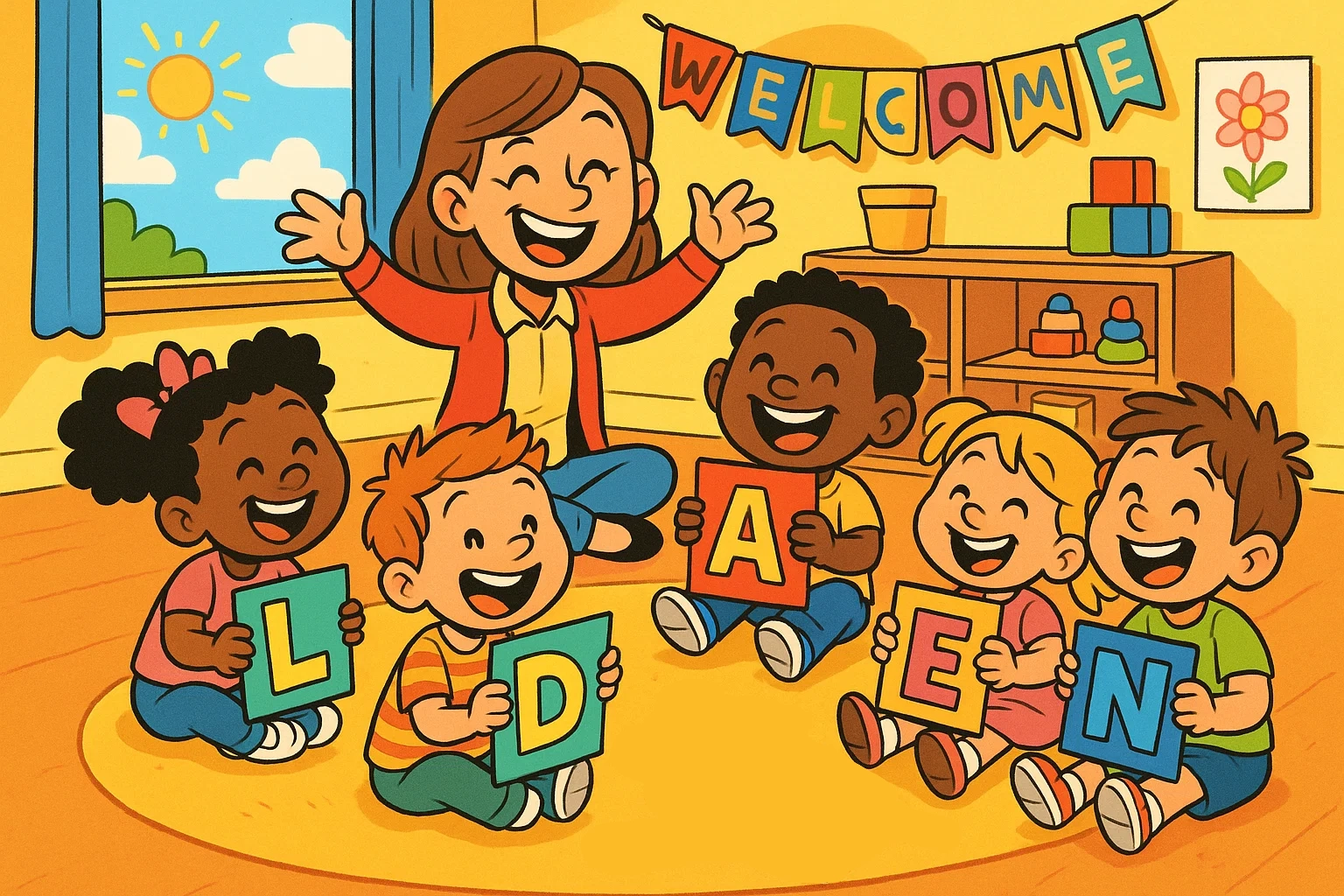
Walking into a preschool classroom on the first day, you’ll likely see children clutching their parents’ hands, eyes wide with uncertainty. Learning each other’s monikers becomes the first bridge to friendship. Name games transform this vulnerable moment into something magical—turning strangers into classmates who recognize, remember, and celebrate one another.
For young learners, recognizing their own label represents a significant milestone in early literacy development. When a child can identify those special letters that belong to them, they’re building foundational skills that extend far beyond simple recognition. They’re developing letter knowledge, understanding print concepts, and gaining confidence in their emerging abilities.
Importance Name Games for Classroom Community
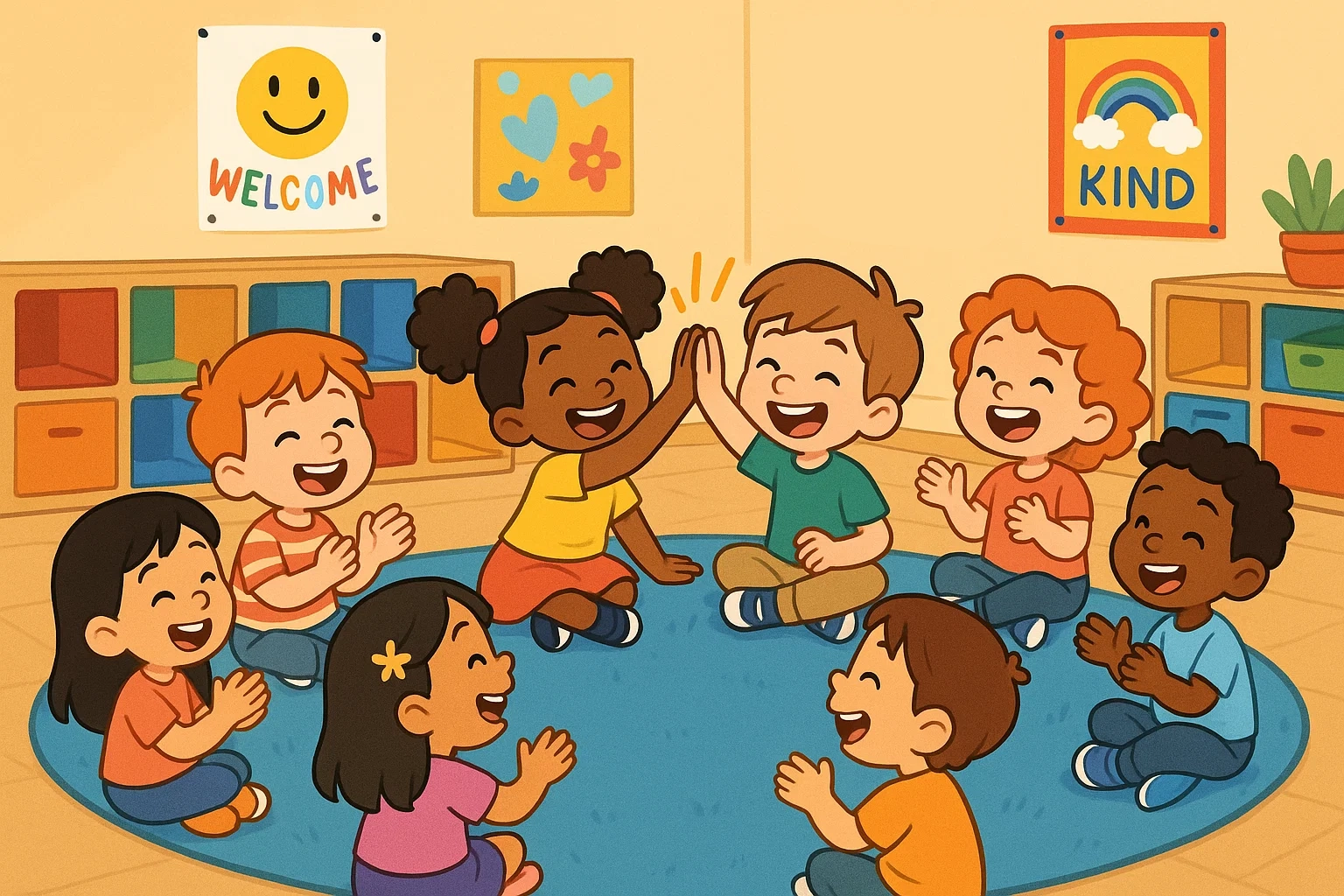
Name recognition serves as a cornerstone of early literacy skills. Beyond academics, designation games help establish a welcoming environment where every child feels seen and valued.
When students become familiar with everyone’s names, they’re more likely to engage with classmates during play, ask for help when needed, and develop the social connections that support learning. The benefits extend to multiple developmental areas:
- Early literacy foundation: Children learn letter-sound correspondence through meaningful context
- Social-emotional growth: Students develop empathy by learning and using peers’ appellations respectfully
- Memory development: Recalling names strengthens cognitive skills applicable to other learning
- Classroom management: Teachers who know student’s name quickly can provide more personalized support
Fun Name Games for First Day of School
The opening days set the tone for your entire year. These icebreaker activities help students introduce themselves while easing first-day jitters.
Name Snowball creates physical movement and laughter. Ask the child to write their title on a piece of paper, crumple it into a “snowball,” then toss it across the circle. Each student picks up a snowball, finds its owner, and shares one thing they learned about that person. This simple activity helps students become comfortable approaching classmates they don’t yet know. Moniker Bingo offers a structured way for students to mingle.
Create bingo cards featuring different characteristics (“has a pet,” “likes pizza,” “plays soccer”). Students must find classmates who match each description and write their names in the corresponding squares. The first to complete a row wins, but the real prize is the conversations that naturally emerge. Acrostic Poems invite creativity from day one. Each student writes their word vertically down a page, then thinks of words describing themselves for each letter. When students share their poems, classmates begin associating labels with faces and personalities. This activity works particularly well with older preschoolers and kindergarteners who are ready for more complex tasks.
Collaborative Name Games: Community Building and Memory
The Game Chain builds incrementally. The first student introduces themselves: “I’m Maria.” The next person says, “That’s Maria, and I’m James.” The third continues: “That’s Maria, that’s James, and I’m Sophia.” As the chain grows, students practice active listening and develop strategies for remembering titles. You might notice some children creating mental associations or repeating names quietly to themselves—valuable memory techniques they’ll use throughout life.
Two Truths and a Name adds an element of mystery. Each student shares their moniker plus three statements about themselves, one of which is false. Classmates guess which statement isn’t true. This variation helps children focus on both names and personal details, creating richer memories of their peers.
Active Interactive Name Games
Movement-based activities channel young children’s natural energy while reinforcing identification recognition. These games acknowledge that preschoolers and kindergarteners learn effectively through their bodies. Beach Ball Name Toss combines coordination with learning.
Write questions on an inflatable beach ball using permanent marker. Students stand in a circle and toss a ball to one another. Whoever catches it answers the question under their right thumb, then says their title before tossing to someone else. The physical element keeps kids engaged while the repetition cements learning.
Variations: Name Toss, Ring Toss, Jumping Games
Ring Toss creates a playful challenge. Arrange plastic bottles or cones in a cluster, each labeled with a student’s word. Children toss rings onto the markers. When successful, they shout out whose name they landed on. This adds kinetic learning to the process of learning names while developing hand-eye coordination.
Jumping Names turns the alphabet into a full-body experience. Lay out letter cards or write letters in chalk on the playground. Call out a student’s moniker, and children jump to each letter in sequence to spell it. Kids love this outdoor name game because it feels like play rather than instruction.
Name Relay Races divide students into teams. Place identity cards at the opposite end of the playing area. When you call a name, one student from each team races to find that card, brings it back, and the next runner goes. This fast-paced activity helps students become familiar with how different names look in print.
Name Game: Ping Pong and Hockey
Ping Pong Names requires only lightweight balls and cups. Label cups with student’s word and arrange them on a table. Children bounce ping pong balls, trying to land them in specific cups. When successful, they practice saying that person’s name. You can adjust difficulty by changing distances or cup sizes based on children’s abilities.
Tabletop Name Hockey uses straws and cotton balls. Write monikers on small cards and place them around a table edge. Students use straws to blow cotton balls toward specific name cards you call out. This game strengthens oral motor skills while making name learning engaging and memorable.
Action Syllables and Letter Building for Name Recognition
Syllable Stomping introduces phonological awareness. Students stomp, clap, or jump for each syllable in their appellation. Maria would stomp three times (Ma-ri-a), while James would stomp once. This helps children understand that names—and all words—break into smaller sound units, a critical pre-reading skill.
Letter Building Challenges use bodies as tools. Students work in small groups to form the letters in students’ monikers using their bodies. For example, three children might arrange themselves to create the letter ‘M’ in Maria. This collaborative activity requires communication, spatial awareness, and problem-solving.
“Follow the String” Game: Name Finding
Hide name cards around your classroom or outdoor space. Attach a long string to each card, leaving the other end visible. Students follow their assigned string, navigating around furniture and classmates, until they discover whose identity awaits at the end. This treasure hunt approach transforms name recognition into an adventure that kids get excited about.
Sensory Games: Learning and Fine Motor Skills
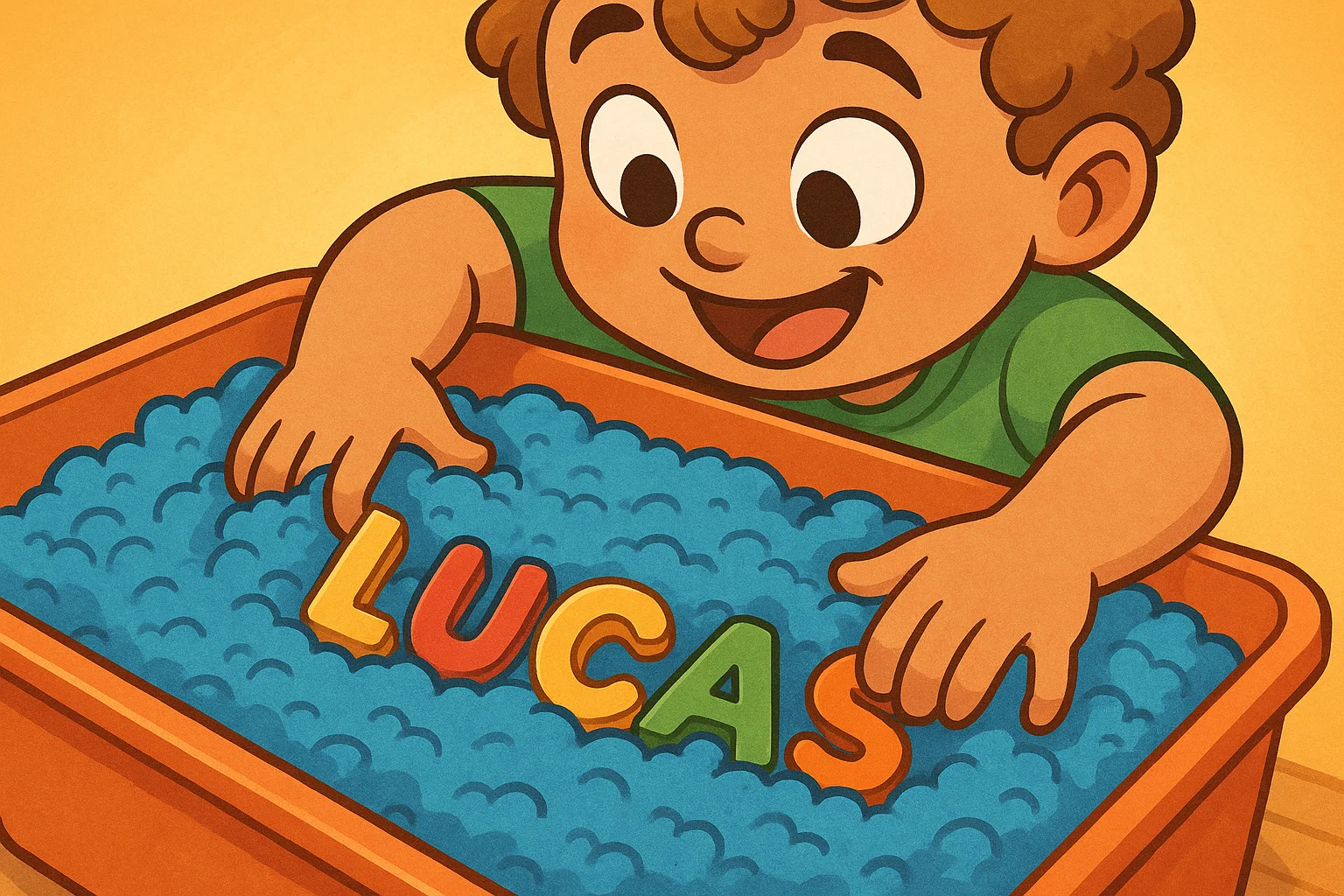
Sensory activities engage multiple learning pathways simultaneously. When children can touch, manipulate, and explore their labels through different textures and materials, they form stronger neural connections than through visual learning alone.
Sensory Bin Ideas to Learn Names
Letter Hunt Bins hide magnetic or foam letters in rice, beans, or sand. Children search for the letters that spell their title, arranging them in correct order once found. The tactile experience of sifting through materials adds a calming, focused element to the learning experience.
Playdough Mats combine tactile play with letter formation. Laminate cards featuring each child’s moniker in large letters. Students roll playdough into “snakes” and shape them to match the letters on their card. This activity develops fine motor skills essential for eventual handwriting while reinforcing letter recognition.
Water Bead offer a unique sensory experience. Write designations on the bottom of a clear container, add water beads, and let children explore. As they move the beads aside, their name appears and disappears, creating a game of discovery that holds attention longer than simple flashcards might.
Teach Kids to Spell Their Name with Kinetic Sand
Kinetic sand’s moldable texture makes it ideal for letter practice. Students can press letter stamps into the sand to spell their word, trace letters with their fingers, or use tools to “write” in the sand. The forgiving nature of this medium reduces frustration—mistakes simply get smoothed away and students try again.
Set up a moniker-writing station where children can work independently. Provide letter stamps, small rakes, and sticks for creating different effects. Some children might spend fifteen minutes perfecting their title, while others experiment with writing classmates’ names—both approaches support learning.
Building Name Using Lego and Mega Blok Sets
Block Letter Construction transforms appellations into three-dimensional creations. Challenge students to build each letter of their name using blocks. This engineering approach appeals to spatial learners and adds problem-solving elements to practice.
Create letter template cards showing how to construct each letter with blocks. Students can reference these guides as they work, developing their ability to follow visual instructions—a skill that supports independence across many classroom activities.
“Parking Garage” Activity for Preschool Name Activity
Label parking spaces in a toy garage with student’s word. Provide small cars for children to “park” in their designated spot. This activity combines pretend play with name recognition, allowing students to practice finding their label in a low-pressure, play-based context.
Extend the activity by creating scenarios: “Can you park in James’s spot?” or “Where should Maria park?” This encourages children to recognize not just their own moniker but everyone’s names in the class.
Games for Name Recognition and Literacy Development
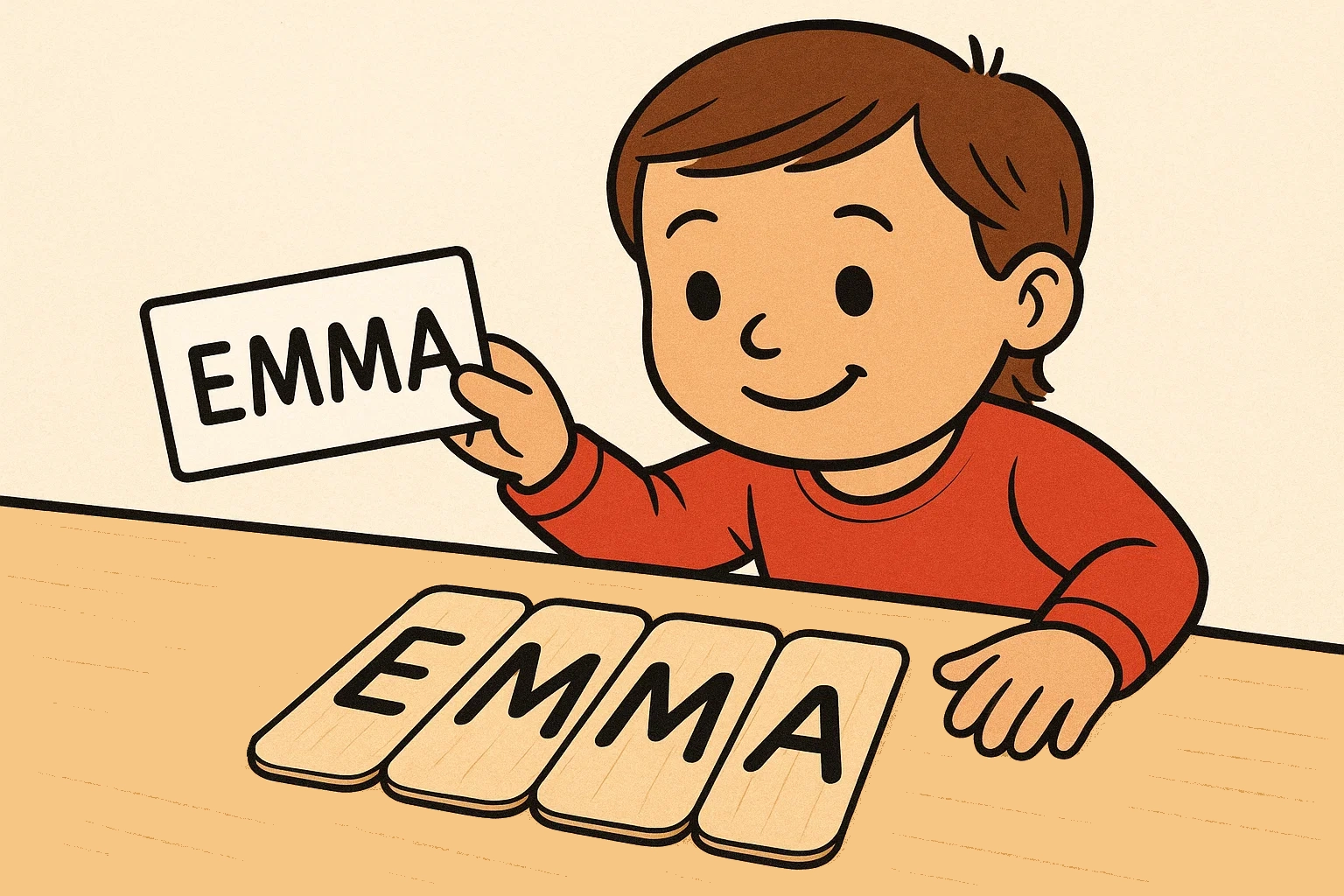
As children progress in their identity recognition skills, you can introduce activities that challenge them to analyze, compare, and manipulate the letters in their names. These games build the foundations for reading and writing beyond just their personal name.
Name Puzzle Varieties: Popsicle Sticks and Crayons
Popsicle Stick Puzzles are simple to create and endlessly useful. Write a child’s title across three to five popsicle sticks placed side by side. Mix up the sticks, and students must arrange them to reveal their name.
As skills develop, increase difficulty by using more sticks or removing some visual cues. Crayon Box Puzzles use a familiar object. Write each letter of a student’s word on individual crayons or crayon cutouts. Store each child’s set in a small box. Students dump out their letters and arrange them correctly. The hands-on manipulation supports learning while the colorful materials maintain engagement.
“Rainbow” Name Tracing Worksheets
Tracing activities build the muscle memory needed for writing. Create worksheets featuring each student’s moniker in large, dotted letters. Children trace their name multiple times using different colors, creating a rainbow effect.
This repetition strengthens fine motor skills and letter formation without feeling monotonous. Vary the activity by having students trace with different tools—regular crayons, thick markers, paint daubers, or even their finger in a shallow tray of sand. Each variation provides different sensory feedback and maintains interest.
Name Search and Scramble for Recognition
Appellation Word Search puzzles work well for children developing visual discrimination skills. Create simple word searches featuring the monikers of students in your class. Students search for their own name first, then challenge themselves to find classmates’ names.
This activity helps children notice letter patterns and develop left-to-right visual tracking. Titles Scrambles present letters out of order. Students must rearrange letter tiles, magnetic letters, or letter cards to correctly spell their name. Begin with just their first name, then progress to including last names or middle initials as skills grow.
Activities: Color by Number and Type the Name
Color by Letter worksheets assign different colors to different letters. A worksheet might show that all the ‘A’s should be red, ‘M’s should be blue, and so on. When children color according to the code, their name emerges from the page. This activity reinforces letter recognition while creating art they can feel proud of.
Typing Practice introduces basic computer skills. Many preschoolers and kindergarteners are fascinated by keyboards. Set up a simple word processor with a large, clear font. Students practice typing their moniker, which helps them locate specific letters on a keyboard—an increasingly relevant skill. The immediate visual feedback of seeing their name appear on screen provides satisfying reinforcement.
Musical Name Games and Songs for Circle Time
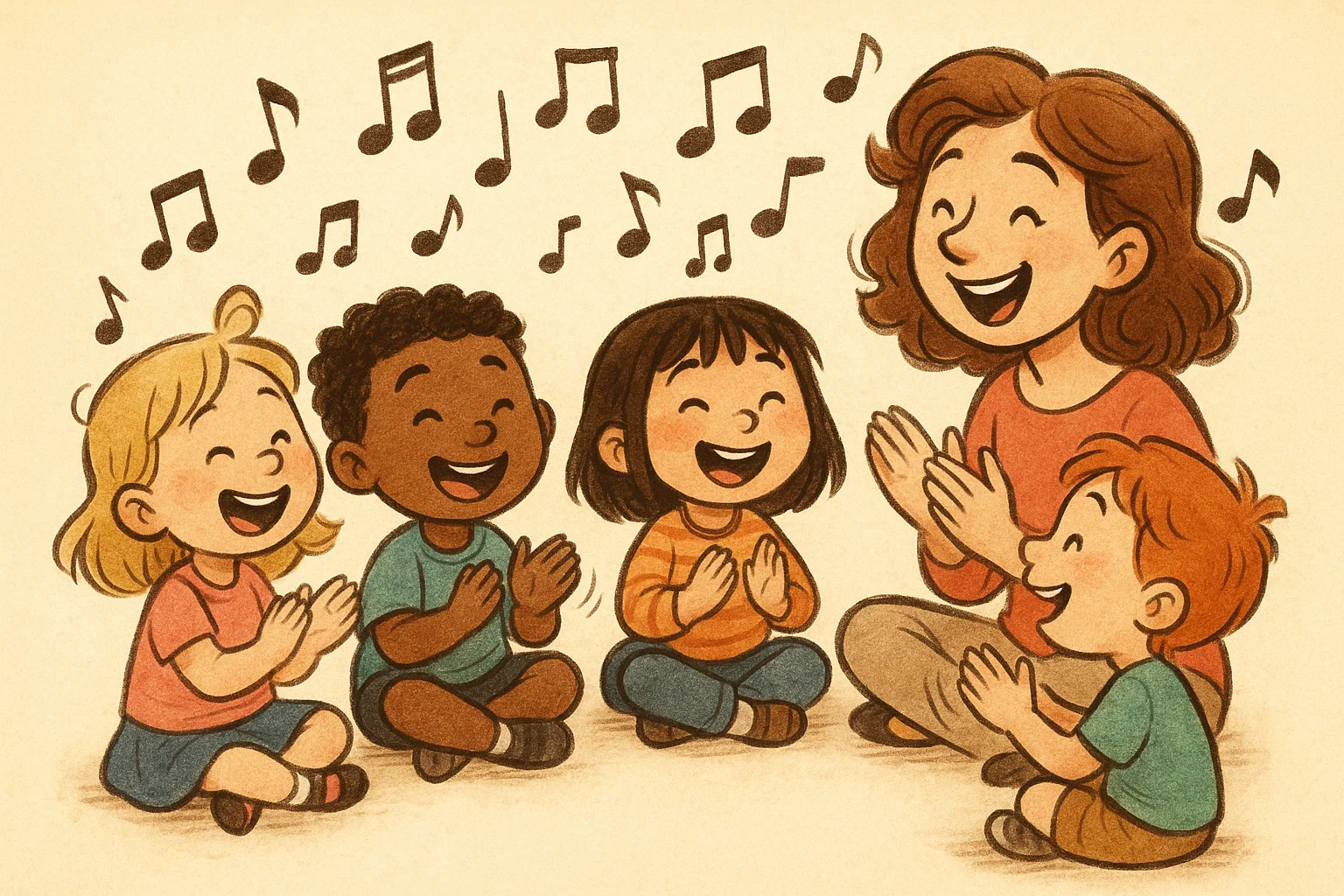
Musical Designation Games and Songs for Circle Time Music naturally captures children’s attention and aids memory. Songs with repetitive patterns help students learn not just names but also rhythm, pattern recognition, and turn-taking skills.
Song “Hickley Pickley Bumblebee”
This traditional word song creates a warm, inclusive atmosphere. The class sings together: “Hickley pickley bumblebee, won’t you say your name for me?” One child responds by singing or saying their name, and everyone echoes it back. The pattern continues around the circle. The sing-song rhythm makes participation feel safe, and shy children often find it easier to say their name within the song structure than in ordinary conversation.
Rhythmic Games: Clapping Name
Moniker Clapping Patterns turn names into percussion. Each child creates a unique clapping pattern. Maria might clap three times (Ma-ri-a), while Ben claps once. The entire class learns and performs each person’s pattern. This activity integrates names with rhythm, engaging both linguistic and musical intelligence.
As students master individual patterns, try clapping two appellations together or creating a class “name symphony” where everyone performs their pattern simultaneously. These variations develop listening skills and pattern recognition.
Games “Jack Box” and “Johnny Whoops”
Jack in the Box combines surprise with name practice. Students crouch low while you chant: “Jack (or Maria) in the box sits so still. Won’t you come out? Yes, I will!” The designated child pops up with arms raised. This simple game helps younger preschoolers associate names with specific peers in a playful context.
Johnny Whoops is a finger play that can be personalized. Touch each of your fingers while saying: “Johnny, Billy, Suzie, Mary…” When you reach your thumb, say “Whoops! Johnny!” Children love the surprise element. Substitute the monikers of students in your class to make it relevant and personal.
Songs: “Who Is Missing?” and “Willoughby Wallaby Woo”
Who Is Missing? develops observation and memory. Students close their eyes while one child hides. When eyes open, the class works together to figure out whose appellation should be called to bring the hidden student back.
This game enhances both name recall and social awareness. Willoughby Wallaby Woo is irresistibly silly: “Willoughby wallaby woo, an elephant sat on you. Willoughby wallaby wee, an elephant sat on me. Willoughby wallaby waria, an elephant sat on Maria!” The rhyming structure and absurd imagery make monikers memorable. Students giggle while unconsciously strengthening their phonological awareness.
Creative Art and Craft Projects with Preschooler Name
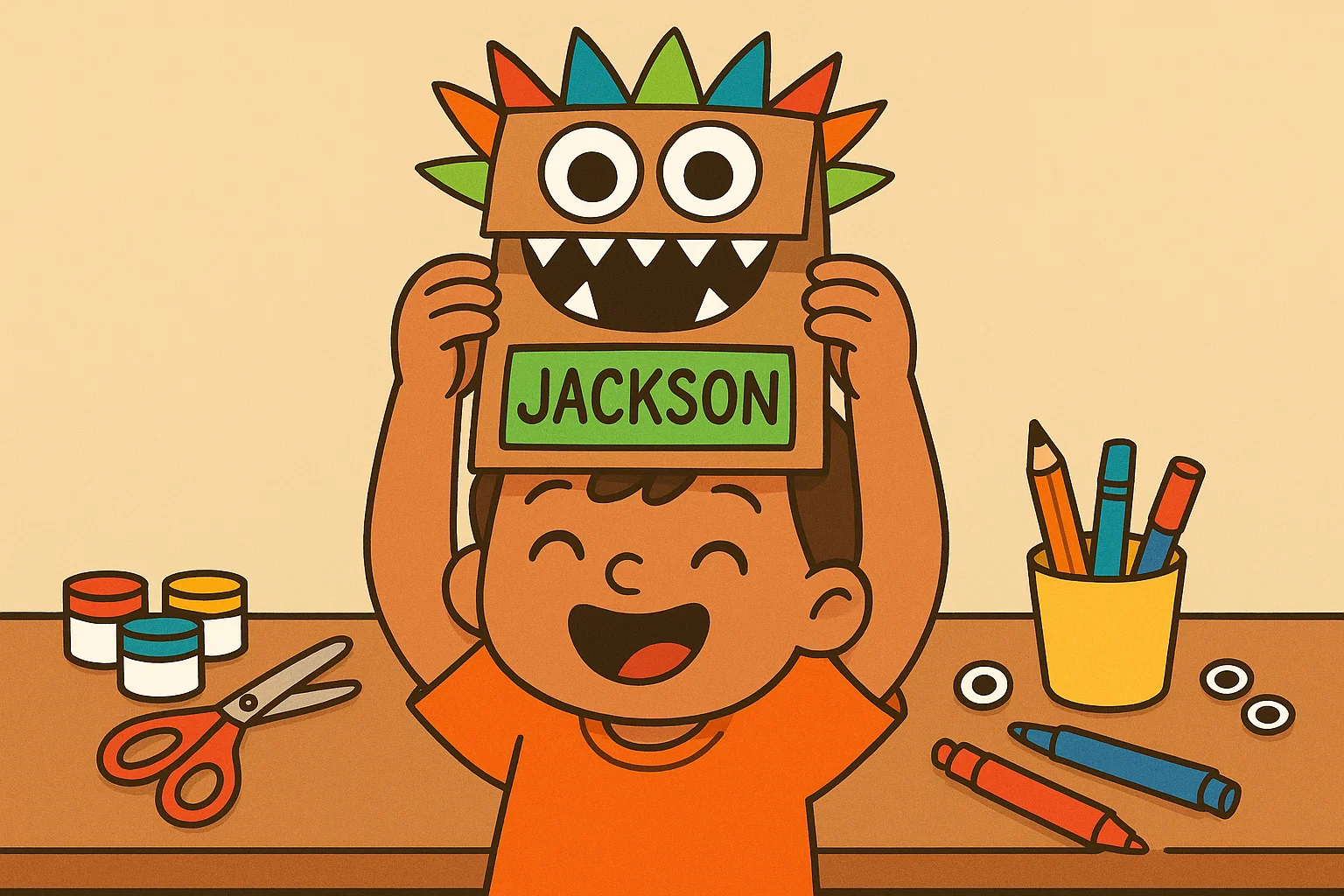
Art projects that incorporate titles allow children to express creativity while practicing letter recognition. These activities produce keepsakes that students take pride in, reinforcing the special significance of their name.
DIY Name Puzzles and Bracelets
Craft Stick Word Puzzles students can make themselves. Each child decorates several craft sticks with markers, stickers, or paint. Once dry, arrange sticks side by side and write the child’s name across them. Store each student’s puzzle in a labeled envelope. Children enjoy both creating and solving their personalized puzzle.
Moniker Bracelets use alphabet beads. Students string beads to spell their name, adding decorative beads between letters if desired. This activity develops fine motor skills and pattern-making abilities. Children wear their creation home, proudly showing parents they can spell their name.
“Hidden Name” Technique and Tape Resist Art Project
Tape Resist Art creates stunning results. Use masking tape or painter’s tape to write a child’s title in large letters on paper or canvas. Students paint over the entire surface with watercolors or tempera paint. When the tape is carefully peeled away, their appellation appears in white against the colorful background—always met with gasps of delight.
This technique can be adapted seasonally. Create tape-resist names on orange paper with fall colors, on blue paper with winter whites and silvers, or on black paper with rainbow colors for a dramatic effect.
“Name Monster Puppets” Craft
Transform monikers into friendly creatures. Each letter in a student’s name becomes part of a puppet design. The first letter might be the monster’s head, middle letters form the body, and the last letter becomes the tail.
Students decorate their title monster with googly eyes, yarn hair, and construction paper features. This craft project helps children see their name as a unique entity while encouraging creativity and storytelling. Many students name their monster and create personalities for them, which extends the learning beyond the art activity itself.
Outdoor Activities
Chalk Appellation Art takes advantage of playground or sidewalk space. Students practice writing their name in large letters using sidewalk chalk. Encourage variations—rainbow names using multiple colors, fancy names with decorative flourishes, or giant names they can walk through.
The large-scale writing movements support motor development differently than small paper-and-pencil tasks. Nature Word Collection sends students on a scavenger hunt. Children gather natural materials—sticks, leaves, pebbles, flowers—and arrange them to spell their name on the ground. This activity connects literacy with nature exploration and produces ephemeral art that can be photographed for documentation.
Holiday and Seasonal Activities
Connecting moniker practice to holidays and seasons maintains engagement throughout the year. These themed activities feel fresh and exciting, even though the underlying learning objective remains consistent.
Christmas Tree and Snowball Activity
Title Ornament Trees invite winter creativity. Students decorate a paper Christmas tree cutout, then add ornament shapes with letters spelling their name. Each ornament gets decorated with glitter, markers, or stickers. Display these around your classroom to create a festive, personalized environment.
Snowball Name Toss (the winter variation) uses white paper “snowballs” labeled with students’ appellations. Children stand in a circle and gently toss snowballs to one another. When catching a snowball, students read whose moniker it shows before tossing to someone new. This simple adaptation of ball-toss games feels fresh because of its seasonal connection.
Easter Egg Activity
Egg Hunt hides plastic eggs containing letter tiles or letter cards. Each student has a set of eggs containing the letters needed to spell their name (multiple eggs if their name has repeated letters). Students hunt for eggs, open them to discover letters, and work to collect all letters in their title. The first to correctly arrange their complete name celebrates success.
Decorated Word Eggs provide an art connection. Students use markers, stickers, or paint to decorate plastic or paper eggs, writing one letter of their name on each egg. These can be strung together to create garlands or displayed in handmade “nests” of shredded paper.
“Rainbow” Name, Fish, and Ice-Cream Scoops
Rainbow Moniker Fish combine an ocean theme with literacy. Students create a fish shape from paper, then fill it with rainbow-colored scales, each scale featuring one letter from their name. Assemble a classroom “aquarium” bulletin board where each student’s name fish “swims.”
Ice Cream Title Scoops taste delicious (figuratively). Students create an ice cream cone from brown paper, then add circular “scoops” above it, one for each letter in their name. They write a letter on each scoop and decorate it with different colors and patterns. The visual of seeing their appellation stacked vertically offers a different perspective than the typical left-to-right orientation.
Water Game for Name Practice
Name Spray offers summer fun. Use a spray bottle filled with water and a large, upright surface (a fence, outdoor wall, or large cardboard). Students “write” their moniker by spraying water. The water darkens the surface temporarily, making letters visible before evaporating. This mess-free option particularly appeals to children who love water play.
Floating Letter Rescue uses a water table or large tub. Float foam or plastic letters in water. Call out a student’s name, and children use nets or their hands to fish out the correct letters, then arrange them on a towel to spell the name. The wet, slippery letters add challenge and sensory interest.
Practical Tips for Successful Game Facilitation
Even the most engaging name game requires thoughtful facilitation. Your approach significantly impacts whether an activity builds confidence or creates anxiety for young learners.
Tips for Facilitating Name Games
Start Simple: Introduce one activity at a time, modeling clearly before students attempt independently. Young children need to see and hear directions multiple times, presented in different ways, before they can successfully follow them.
Celebrate Effort Over Perfection: When a child struggles to recognize or write their title, focus on progress. “You found the first letter in your name!” provides more encouragement than “That’s not quite right.”
Create Inclusive Opportunities: Some students will recognize their word immediately, while others need months of practice. Offer varied difficulty levels so each child experiences success. For instance, some children might spell their entire first and last name during a puzzle activity, while others work on just their first name.
Use Visual Supports: Display a moniker wall or name chart where students can reference how names are spelled. This promotes independence and reduces frustration when children can’t remember their letters.
Maintain Consistent Routines: Incorporate designation games into your daily schedule—perhaps during morning circle time or before transitions. This consistency helps children know what to expect and builds confidence through repetition.
Honor All Appellations: Some children have longer, culturally significant names that might take more time to learn. Show equal enthusiasm for all names, helping students understand that diversity strengthens your classroom community. This models respect and inclusivity that shapes children’s social development.
Name Games for Different Age Groups
Young Preschoolers (Ages 3-4):
- Focus on recognizing their written title among others.
- Simple matching games, name puzzles with just 3-4 letters, and songs work well.
- These children are building the foundational understanding that those specific letters represent them.
Older Preschoolers (Ages 4-5):
- Challenge students to begin identifying individual letters in their word, attempt writing some letters (even if formation isn’t perfect), and recognize classmates’ names.
- They can handle more complex games like bingo or spelling their name with various materials.
Kindergarteners (Ages 5-6):
- Expect these students to write their name independently, recognize all letters, and tackle spelling simple classmates’ monikers.
- They can engage with word searches, typing activities, and games requiring reading multiple names quickly.
Remember that age is just one factor. Developmental readiness varies significantly, so observe each learner carefully and adjust your expectations accordingly.
Optimal Duration for Name Games
Optimal Duration for Title Games Short Attention Spans Require Brief Activities: Most preschoolers can focus for 10-15 minutes on a structured activity, while kindergarteners might manage 15-20 minutes.
Daily Repetition Trumps Marathon Sessions: Five minutes of identity practice daily yields better results than a single 30-minute session weekly. Brief, consistent exposure helps cement learning without overwhelming young minds.
Watch for Natural Endpoints: When several children become restless, off-task, or disruptive, the activity has likely run its course. End on a positive note rather than continuing until everyone is frustrated. Balance Active and Quiet: Alternate between high-energy moniker games (tossing, running, jumping) and calmer activities (puzzles, writing, art projects). This variety accommodates different learning styles and energy levels throughout your day.
Why These Games are Necessary in Kindergarten
Even though many kindergarteners enter school recognizing their appellation, dedicated name activities remain valuable throughout the year. Here’s why:
- They Foster a Sense of Community: Learning everyone’s name creates interpersonal connections that transform a collection of individuals into a cohesive classroom community. Students who feel known and recognized are more likely to take social risks, ask questions, and collaborate with peers.
- They Build Early Literacy Skills: Word recognition opens the door to broader literacy concepts. Students learn letter-sound relationships, realizing that print carries meaning, develop left-to-right directionality, and build phonological awareness through their name and classmates’ names.
- They Enhance the Learning Environment: When children feel safe and included, they’re better positioned to learn. Moniker games at the beginning of the year establish norms of respect and inclusion that influence behavior throughout the coming months.
- They Support Differentiated Instruction: Through identity activities, you’ll quickly identify which students need additional support with letter recognition, which are ready for advanced challenges, and which have strong visual memory skills. This information guides your instructional planning across all subject areas.
- They Create Positive Associations with School: Many children’s first successful reading experience is recognizing their own name. This accomplishment builds confidence that propels them forward in their literacy journey. When learning feels achievable and fun, students develop positive attitudes toward education that can last a lifetime.
